This page describes the different price calculation methods available in Norce Commerce. Each method can be applied to price lists, price rules, or overridden at the product level. All methods are predefined and cannot be extended. The final sales price is determined after applying price rounding logic.
Each price method defines how the sale price is calculated. The following sections describe each method, including calculation logic and relevant context.
Description:
The price is set to a fixed value per product, excluding VAT. This method is typically used at the product level, especially when pricing is controlled by an external ERP system.
Image:
"Fixed price" method illustration.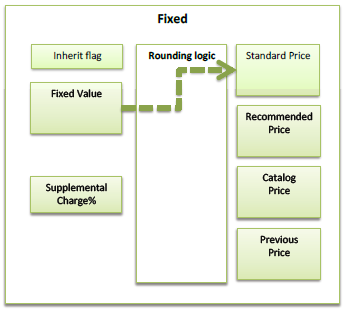
Description:
The sale price is calculated by adding a specified uplift percentage to the product's purchase cost. The purchase cost is sourced from the resupply purchase cost field.
Image:
"Cost plus purchase cost" method illustration.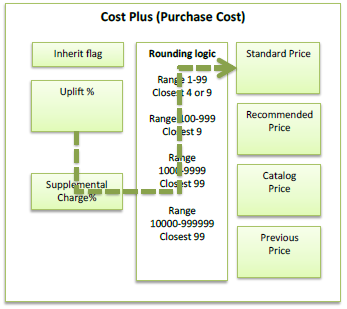
Description:
The sale price is calculated to achieve a specified margin percentage over the purchase cost. The purchase cost is sourced from the resupply purchase cost field.
Image:
"Margin purchase cost" method illustration.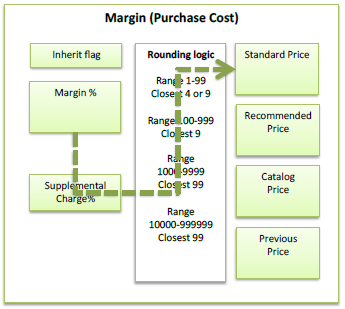
Description:
The sale price is calculated by adding a specified uplift percentage to the unit cost. The unit cost is based on the remaining inventory.
Image:
"Cost plus unit cost" method illustration.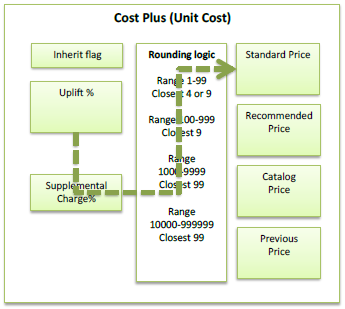
Description:
The sale price is calculated to achieve a specified margin percentage over the unit cost. The unit cost is based on the remaining inventory.
Image:
"Margin unit cost" method illustration.
Description:
The recommended price, inherited from the primary price list, is used as the base for calculation. The final price is adjusted by a rebate percentage. If no recommended price is set, the standard price is used as a fallback.
Image:
"Recommended price" method illustration.
Description:
The standard price, inherited from the parent price list, is used as the base. The final price is adjusted by a rebate percentage (can be positive or negative).
Image:
"Standard price percent" method illustration.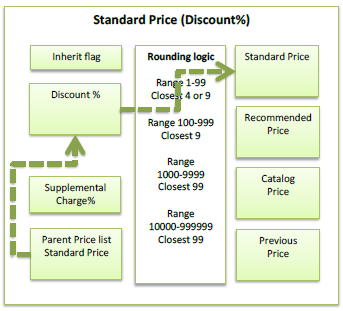
Description:
The standard price, inherited from the primary price list, is used as the base. The final price is adjusted by a fixed value (can be positive or negative).
Image:
"Standard price fixed" method illustration.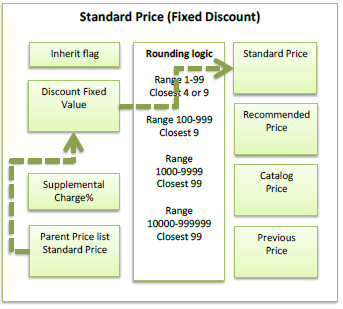
Description:
The sale price is calculated using competitive pricing rules, with assigned target and minimum margin percentages. The purchase cost is sourced from the resupply purchase cost field.
Image:
"Competitive pricing" method illustration.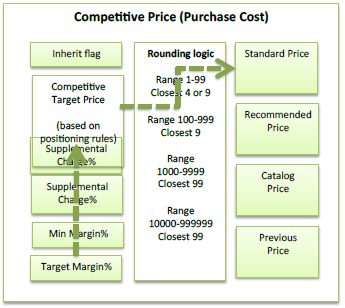
Description:
The sale price is calculated using competitive pricing rules, with assigned target and minimum margin percentages. The unit cost is based on the remaining inventory.
Description:
For product packages, the "Structure Calculation" method calculates the package price based on the prices of included products. There are three options:
Standard Price:
The package price is the sum of the standard prices of the contained products, with optional percentage rebates.Distribute Price:
A target (fixed) price is set for the package, and the price is distributed proportionally to the contained products based on their sale price amounts.Use Item Price Rule:
Different price rules can be set for each product in the package (e.g., fixed price, cost plus, margin, use recommended price, or use standard price).
Description:
Norce Commerce uses a client-specific framework for rounding prices. This framework automates cosmetic price rounding for calculated prices. Rounding rules are defined by price ranges and can target prices including or excluding VAT.
- Rounding may affect the final standard price.
- Minimum margin percentage limitations are always protected.
- In some cases, rounding may prevent matching a competitor's price if minimum margin rules apply.
Description:
Automatic fallback rules determine which cost value to use when calculating prices:
| Rule Based On | Is In Stock | Cost Unit Value | Cost Purchase Value | Result |
|---|---|---|---|---|
| CostUnit | False | - | > 0.00 | Use Cost Purchase instead |
| CostUnit | - | = 0.00 | > 0.00 | Use Cost Purchase instead |
| CostPurchase | - | > 0.00 | = 0.00 | Use Cost Unit instead |
Description:
A supplement charge can be added to the cost before applying the price method. Only one supplement value is used:
- If a supplement charge percentage is set, it is used.
- Otherwise, if a supplement charge value is set, it is used.
Description:
For price methods where margin is relevant, the calculated price is compared to the minimum margin sale price (based on the relevant cost and supplement charge). If the calculated price is lower than the minimum margin sale price, the minimum margin sale price is used.